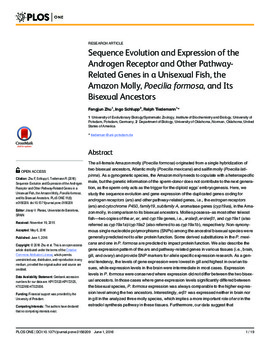| dc.contributor.author | Fangjun Zhu | |
| dc.contributor.author | Ingo Schlupp | |
| dc.contributor.author | Ralph Tiedemann | |
| dc.date.accessioned | 2017-03-04T01:59:59Z | |
| dc.date.available | 2017-03-04T01:59:59Z | |
| dc.date.issued | 2016-06-01 | |
| dc.identifier.citation | Zhu F, Schlupp I, Tiedemann R (2016) Sequence Evolution and Expression of the Androgen Receptor and Other Pathway-Related Genes in a Unisexual Fish, the Amazon Molly, Poecilia formosa, and Its Bisexual Ancestors. PLoS ONE 11(6): e0156209. doi:10.1371/journal.pone.0156209 | en_US |
| dc.identifier.uri | https://hdl.handle.net/11244/49239 | |
| dc.description | We are thankful to Prof. Dr. Manfred Schartl for kindly providing P. formosa and P. latipinna fishes. We thank Dr. Luis Valente for his help on statistical analysis in R. We also thank Dr. Francesco Lamanna for his help on phylogenetic analysis and comments. We thank Ina-Maria Schedina for tissue collecting and Dr. Sandra Schwarte for discussion. Two reviewers provided very valuable comments on a previous version of the manuscript. Financial support was provided by the University of Potsdam. | en_US |
| dc.description | | en_US |
| dc.description.abstract | The all-female Amazon molly (Poecilia formosa) originated from a single hybridization of two bisexual ancestors, Atlantic molly (Poecilia mexicana) and sailfin molly (Poecilia latipinna). As a gynogenetic species, the Amazon molly needs to copulate with a heterospecific male, but the genetic information of the sperm-donor does not contribute to the next generation, as the sperm only acts as the trigger for the diploid eggs’ embryogenesis. Here, we study the sequence evolution and gene expression of the duplicated genes coding for androgen receptors (ars) and other pathway-related genes, i.e., the estrogen receptors (ers) and cytochrome P450, family19, subfamily A, aromatase genes (cyp19as), in the Amazon molly, in comparison to its bisexual ancestors. Mollies possess–as most other teleost fish—two copies of the ar, er, and cyp19a genes, i.e., arα/arβ, erα/erβ1, and cyp19a1 (also referred as cyp19a1a)/cyp19a2 (also referred to as cyp19a1b), respectively. Non-synonymous single nucleotide polymorphisms (SNPs) among the ancestral bisexual species were generally predicted not to alter protein function. Some derived substitutions in the P. mexicana and one in P. formosa are predicted to impact protein function. We also describe the gene expression pattern of the ars and pathway-related genes in various tissues (i.e., brain, gill, and ovary) and provide SNP markers for allele specific expression research. As a general tendency, the levels of gene expression were lowest in gill and highest in ovarian tissues, while expression levels in the brain were intermediate in most cases. Expression levels in P. formosa were conserved where expression did not differ between the two bisexual ancestors. In those cases where gene expression levels significantly differed between the bisexual species, P. formosa expression was always comparable to the higher expression level among the two ancestors. Interestingly, erβ1 was expressed neither in brain nor in gill in the analyzed three molly species, which implies a more important role of erα in the estradiol synthesis pathway in these tissues. Furthermore, our data suggest that interactions of steroid-signaling pathway genes differ across tissues, in particular the interactions of ars and cyp19as. | en_US |
| dc.language.iso | en_US | en_US |
| dc.publisher | PLos One | |
| dc.relation.ispartofseries | PLoS ONE 11(6): e0156209 | |
| dc.relation.uri | http://www.plosone.org/article/info%3Adoi%2F10.1371%2Fjournal.pone.0156209 | |
| dc.rights | Attribution 3.0 United States | |
| dc.rights.uri | https://creativecommons.org/licenses/by/3.0/us/ | |
| dc.subject | Gene expression,Ovaries,Androgens,Estrogens,Evolutionary genetics,Phylogenetic analysis,Polymerase chain reaction,Sex hormones | en_US |
| dc.title | Sequence Evolution and Expression of the Androgen Receptor and Other Pathway-Related Genes in a Unisexual Fish, the Amazon Molly, Poecilia formosa, and Its Bisexual Ancestors | en_US |
| dc.type | Research Article | en_US |
| dc.description.peerreview | Yes | en_US |
| dc.description.peerreviewnotes | http://www.plosone.org/static/editorial#peer | en_US |
| dc.identifier.doi | 10.1371/journal.pone.0156209 | en_US |
| dc.rights.requestable | false | en_US |

